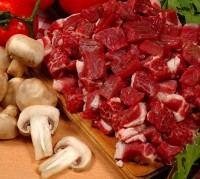How to Identify Quality Meat
 Meat is a fantastic food that the majority of us enjoy on a fairly frequent basis.
Meat is a fantastic food that the majority of us enjoy on a fairly frequent basis.
Just like any other produce, however, sometimes we will encounter those meats that are stringy, tough and tasteless. A lot of this has to do with with how the animals were fed, what condition they were in when slaughtered, and how you cook the meat yourself. For the sake of this blog, we’ll be using beef as an example.
How they were fed
When it comes to how animals were fed before being slaughtered and cured, there is often the debate between the natural and unnatural means. Hormones vs no hormones, free-range vs caged, grain-fed vs grass fed, etc. Of course while it is inevitable that we will often end up consuming meat that go to where it was using the likes of hormones, certain farms will operate differently.
Ideally they will be fed naturally and allowed to reach their ideal state on their own. However, cows can be force-fed in terms of grains so that they fatten up enough before being slaughtered. There are ways to tell this by looking at the meat, one of the key indicators being what is known as ‘marbling’ on the meat.
Marbling are those spots of fat you may see throughout your meat. Generally the more marbling there is, the more the cow could have potentially been fattened. However, certain breeds – such as Angus beef – typically have more marbling than others.
Ideally, the beef you’d want is organic, grass-fed and comes from a cow that was free to move around as opposed to locked up. Grass-fed beef is typically less fatty (with its fat possessing a yellowish colour), a healthier red colour and tastier than grain-fed beef. However, both can be enjoyed as long as you cook them appropriately.
Condition they were in
When we talk about condition, we don’t mean whether they were fat or lean. Rather this refers to the mental state a cow was in before it was slaughtered. When looking at beef, observe how intense the red of the meat is. If it is a dark red, then this means the cow it came from was most likely stressed before being slaughtered. The result is typically a meat that is notably stringy.
A cow that was calm before the slaughtered will generally result in meat that is a brighter red that is also more tender than that of meat that came from a cow that was under notable stress.
How you cook the meat
Now with a bit more knowledge of how to determine higher quality meat from less ideal counterparts, you have to account for how you cook it.
If your meat has a large amount of marbling, this means that you can be a little more forceful with your cooking. The marbling naturally helps maintain the tenderness of the meat more easily but is also less healthy for you. But if that’s not an issue, then you can go ahead and cook beef with visible marbling for a while and not hurt its tenderness that much.
Higher quality and less fatty meats – such as grass-fed beef – requires the opposite. However, because grass-fed beef is notably better, it also means you can cook it to rarer conditions with less risk to your health. In fact, beef that is of a substantially high quality can be consumed raw – but that is certainly an acquired taste.
How do you identify quality meat, be it red or white? Share your tips with us in the comments below.
* Image source: Suat Eman / FreeDigitalPhotos.net